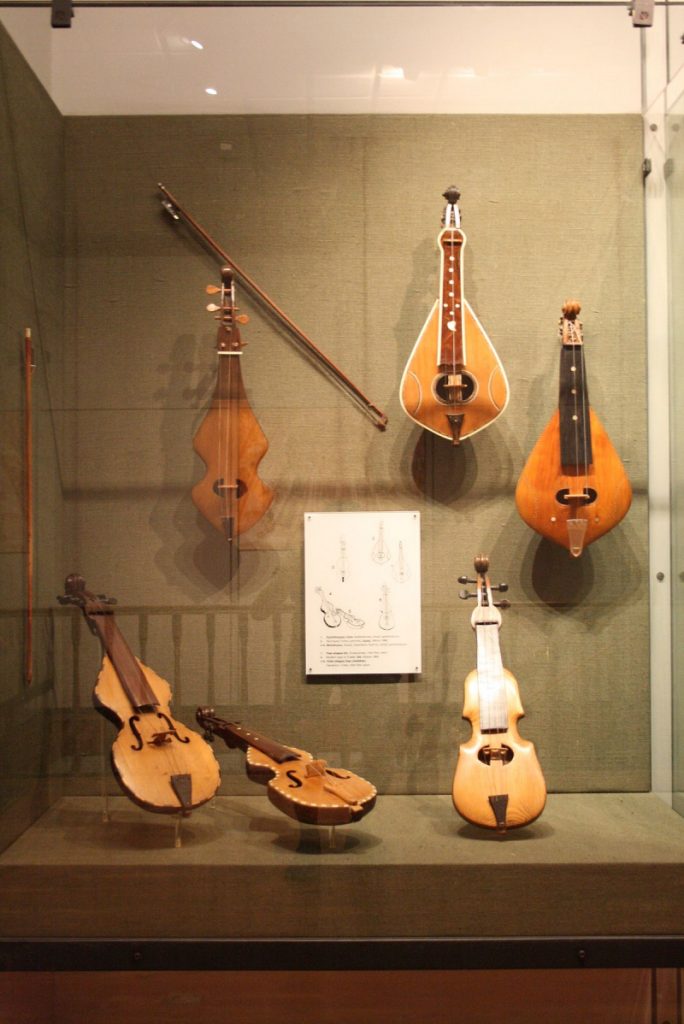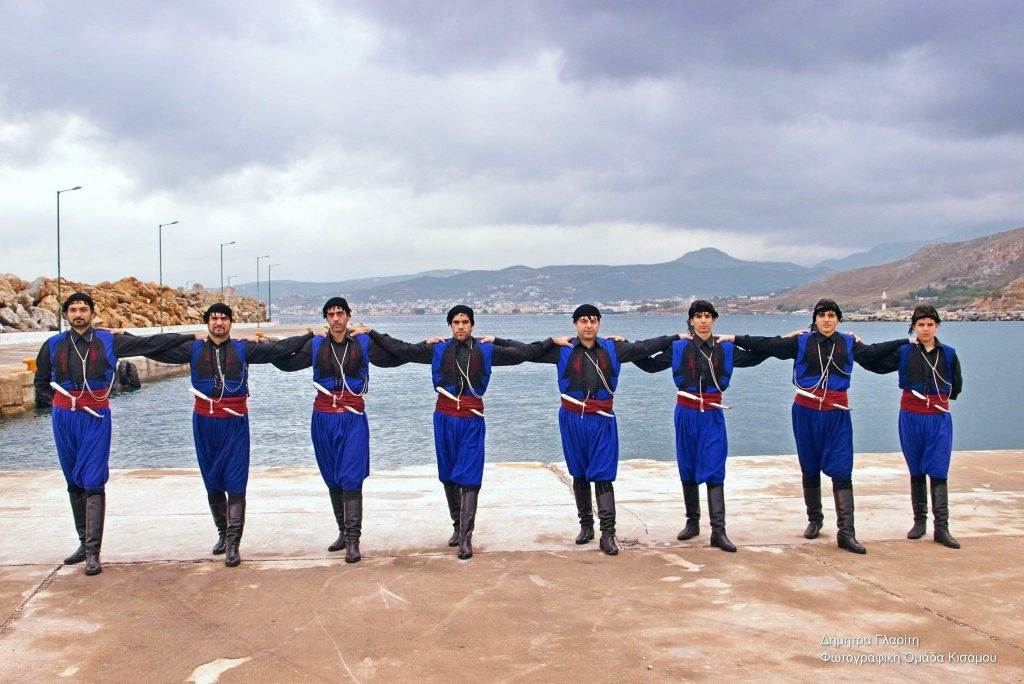
Crete has many crafts and was always inclining to arts. Crete has produced many musicians,painters and many more artists to excel in many countries and not only within Greece. In this section we will give you a small taste and information about music and dances in Crete.
The music of Crete, also called Kritika, refers to the traditional Greek folk music prevalent on the island of Crete. Cretan traditional music includes instrumental parts, Capella songs known as the rizitika, Erotokritos with a vigorous tradition of singing excerpts of the Erotokritos to a specific set of tunes as a “song” genre in its own right (with or without instrumental accompaniment).The entire set of tunes will repeat as many times as required for the length of the excerpt that is being sung.
Tabachaniotika songs are a Cretan urban musical repertory of instrumental and vocal music which belongs to a broader family of urban genres and other songs and folk genres (lullabies, ritual laments, poems etc.).
Over the course of the twentieth-century, the sense of a single, island-wide Cretan musical tradition emerged. Although much Cretan music remains consciously close to its folk roots and an integral part of Cretans’ everyday lives, it is also vibrant and evolving constantly.
Modern popular tradition involves many professionals and semi-professional musicians, numerous regional record companies and professional distributors.

Dances of Crete
The dances of Crete express the rich inner world of its people. With dancing and singing, the Cretan expresses his feelings, enthusiasm, disappointment, love and love.
However, although the dancing repertoire of the Cretans is rich, a lot of dances have been pushed aside due to evolution and some have even got forgotten. Although all the Cretan dances are danced all over the island and have their roots in the ancient Minoan ceremonies, every dance has something distinct.
Dances that are still been danced in Crete are:
1.Siganos 4.Pentozali
2.Syrtos 5.Sousta
3.Maleviziotis 6.Dournerakia
Dances that are no longer danced or lost poppularity are:
1.Agaliastos 2.Zervopesso 3.Koutsabadian 4.Absorbed 5.Trizalis 6.Laziotis 7.Principle 8.Anogian jingle 9.Ethnic jingle 10.Lacethaic jingle 12.Xenomasharis 13.Little baby 14.Rumanian spoon 15.Queens 16.Sotis 17.Rhodes
Siganos
Siganos is also called Dance of Theseus or Bridal Dance. The dancers are tight and walk in small, quiet steps, with the protester seemingly dragging this human chain trying to lead her out of the Labyrinth into salvation.
The dance is completed with six or eight steps, with eight steps is danced in Milopotamos, generally is characterized as a tourist dance. Dance of the Bride dancing at weddings with the groom in front and the bride next to him. Today, however, the Syrthos is considered to be the Dance of the Bride.
One version about how the dance came to be is that the Turks in the Turkish-occupied Crete to have forbidden the Cretans to dance revolutionary dances. So the Cretans invented the Siganos that looks very much in the footsteps of Pendoza to not forget this great dance. In its present form the dancers are now caught by the shoulders.
Siganos is the introduction to Pentozali. There are a lot of melodies that are known to us as “conciliaries”, most of which come from Lasithi and the eastern provinces of Heraklion, so Siganos is considered a dance of eastern Crete, accompanied very often by a series of couplets, sarcastic, erotic, of grief and pain.
Sirtos
Sirtos or sertos is probably the most popular dance today in Crete. It is a slow dance, and is accompanied by lyre or violin, lute, mandolin or askomantoura in the mountainous regions. in the form we meet today took place in the prefecture of Chania and especially in the province of Kissamos, so we will hear it also Kissamitiko.
It is also called “dance of love”. Serratos or Syratos is called because the dancer’s legs crawl on the ground without losing their contact with the land. It is completed with eleven or twelve steps, when it is danced with eleven steps it keeps one rhythm, and its pace is circular, with hands in a distance looking upwards.
The dancers shape a circle which closes and opens inwards. The circle is led by the first dancer, who has the possibility to improvise, making small variants in the pace, shaping the figures, small complicated steps, however without enthusiasm and big jumps, and without exiting the circle, he makes turns and moves that take off the dance.
After he finishes, he goes last one and the second dancer becomes first making his improvisions. Nowadays the strict structure of the dance has been lost. It is dancing by men and women dancing from the palms to the shoulders and with a host of figures unimportant and the meaning of dance.
Maleviziotis
Maleviziotis is a swift dance with 16 steps. The accompanying music is played by violin or lyre with lute, mandolin or askomantoura in the mountainous regions. it is danced by men and women who are caught by the palms at the shoulders and bent elbows.
With his fast pace and liveliness, he gives the dancer the chance to show his splendor, his ability to improvise and impress with his jumps. It is the most difficult, but also the most beloved dance of Crete. It is leaping, noisy, enthusiastic and dynamic dance. Dance differs from mountainous to candy regions.
Pentozalis
The dance takes its name from his five basic steps, which are repeated ten times. It is one of the most spectacular and perhaps the most famous dance of Crete. First started from Chania although it is generally considered to be the dance of all Crete. At the beginning he was a purely male dance and was dancing by men armed.
The black crowned scarf wearing the dancers testifies to the sacrifices of the Cretan people. Slowly began to dance also by women. The dancers are caught by the shoulders. In Pentozali, the front does not engage in individual figures, but is integrated with the group by performing only group figurines. The multiple strokes of the dancers on the ground are symbolic of the arms crossing in the battle. Women do not perform group or individual figures. In Kissamos it is common to call the name of each chieftain in every turn of the melody.
The accompanying music is played by violin or lyre with lute, mandolin and askomantoura in the mountainous regions. In Pentozalis the first dancer, in absolute agreement with the rest of the dancers, hasa restriction of improvisation, his steps are ritual and counted. Women do not often lead in Pentozalis.
Sousta
Sousta is the opposite dance of Crete, that has a lot of elements from the ancient pirihios.
Around 300 AD the dance began to be danced by women and so it got an erotic character. It is said that women’s participation in the dance was a social requirement of the time. Due to the severity of the morals, almost all women married without even having ever seen their prospective husband. Sousta because it is danced in couples, gave the opportunity to the two young people to find themselves, without the fear of social outrage.
The dance is being danced holding palms all together, shaping in the beginning a semicircle, afterwards they separate and stand the one opposite the other making two teams, on of the men and and one of the women. With the movements of the hands and the head, a discussion is developed little by little. Till in the end, befalls the union.
The evolution of dance is therefore an erotic story and each dancer plays his/her own role. The accompanying music is played with lyre or violin and lute, mandolin or askomantoura in the mountainous regions. Its basic steps are three. The Sousta as a dance has its roots from the ancient pirihios that is considered the most ancient Cretan martial dance.
Dournerakia
Dournerakia, unlike the other dances we have seen so far, has no Cretan roots. It is a foreign dance that appeared around 1900 and is based on Serbian dances. Men and women participate in the dance. The dancers are caught by the shoulders. His footsteps are six and resemble a fast “Sigan”.
It is our known “Hashaposervic”. In our musical tradition he went on with the title “Dournarakia” around 1960 thanks to Kostas Mountakis, who included the dance on a disc with this title. Since then, we have considered yet another piece of our music-dancing tradition.